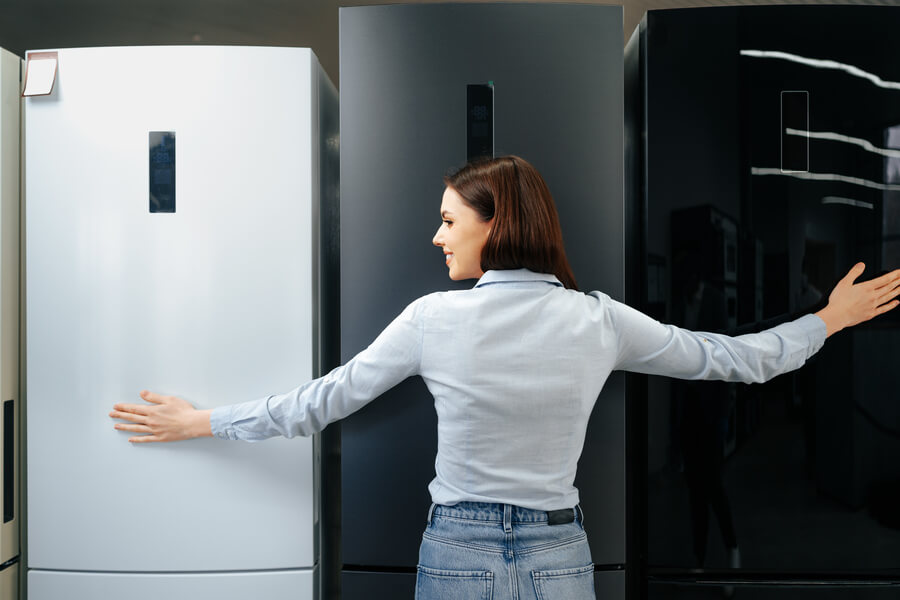Refrigerator temperature fluctuations pose a common challenge, impacting the freshness of stored goods. This article explores the diverse causes behind these temperature shifts and presents targeted solutions to restore consistent cooling performance, so let’s jump right in.

Refrigerator Temperature Fluctuates: 12 Possible Causes
Refrigerator temperature fluctuations arise due to various factors, including issues with the thermostat, dirty coils, damaged seals, and problems with the compressor. Recognizing these challenges is essential for addressing and resolving temperature inconsistencies.
1. Thermostat Issues
The thermostat is the temperature control device. If it malfunctions, it may not accurately read the temperature, leading to improper regulation. This can result in the refrigerator overcooling or not maintaining the set temperature.
Solution:
- Unplug the refrigerator from the power source. Locate the thermostat, usually inside the refrigerator compartment.
- Remove the thermostat cover or housing.
- Disconnect the wires from the old thermostat and remove it.
- Install the new thermostat, ensuring proper wiring.
- Calibrate the thermostat according to the manufacturer’s instructions.
- Replace the cover or housing and plug the refrigerator back in.
2. Dirty Coils
Condenser coils release heat from the refrigerator. The heat exchange process becomes less efficient when they accumulate dust and dirt. This inefficiency can cause temperature fluctuations as the system struggles to maintain the desired temperature.
Solution:
- Unplug the refrigerator and locate the condenser coils, usually on the back or underneath.
- Use a vacuum or coil cleaning brush to remove dust and dirt.
- For thorough cleaning, consider using a coil cleaning solution.
- Vacuum or wipe away any debris around the coils.
- Plug the refrigerator back in and monitor temperature changes.
3. Damaged Door Seals
Door seals create an airtight barrier. If they’re damaged, cracked, or loose, cold air leaks, and warm air enters. This constant exchange disrupts the balance, leading to temperature fluctuations within the refrigerator.
Solution:
- Inspect the door seals for cracks, looseness, or damage.
- Remove the damaged seals by pulling them out of their channels.
- Clean the seal channels with mild soap and water.
- Install the new seals, ensuring they’re correctly aligned.
- Use a hairdryer to soften the seals if needed for a secure fit.
- Close the door and check for any leaks or cold air.

4. Overloading
Overloading the refrigerator with too much food obstructs the natural airflow. This can lead to uneven cooling as the air struggles to circulate properly, causing some areas to be colder than others.
Solution:
- Organize items to allow for even distribution and proper airflow.
- Avoid overloading shelves and drawers; follow recommended storage guidelines.
- Consider adjusting the refrigerator’s temperature settings based on the food quantity.
5. Faulty Evaporator Fan
The evaporator fan circulates cold air throughout the refrigerator. Certain areas may not receive adequate cooling if it malfunctions, resulting in temperature inconsistencies. Let’s learn how to determine if you have a faulty evaporator fan:
Solution:
- Unplug the refrigerator and locate the evaporator fan, often found in the freezer compartment.
- Check for any obstructions or visible damage.
- If necessary, remove the fan cover and inspect the blades.
- Replace a malfunctioning fan with the appropriate replacement part.
- Regularly clean the fan blades to prevent dust accumulation.
6. Refrigerant Issues
Refrigerant is crucial for the cooling process. Low levels or leaks can impede the refrigerator’s ability to remove heat, causing temperature fluctuations.
Solution:
- Consult a professional technician to assess refrigerant levels and identify leaks.
- The technician will recharge the system with the appropriate refrigerant if low levels are detected.
- Promptly repair any identified leaks to prevent further issues.
7. Condenser Fan Problems
Similar to the evaporator fan, the condenser fan helps dissipate heat. Issues with this fan can lead to inadequate heat dissipation, affecting the overall cooling performance of the refrigerator.
Solution:
- Unplug the refrigerator and locate the condenser fan, typically near the compressor.
- Check for obstructions or visible damage.
- Replace a malfunctioning fan with a compatible replacement.
- Ensure the fan operates smoothly to facilitate efficient heat dissipation.
8. Placement of Items
Incorrect placement of items can obstruct vents and airflow channels within the refrigerator. This disrupts the even distribution of cold air, resulting in temperature variations.
Solution:
- Organize items to allow for unobstructed airflow around vents.
- Avoid placing large items directly in front of vents.
- Refer to the refrigerator’s user manual for recommended storage configurations to ensure proper ventilation.
9. Power Supply Issues
Fluctuations in power supply or electrical issues can impact the performance of the refrigerator’s cooling system. Consistent power can lead to consistent cooling. Here’s how to determine if you’re facing power supply issues:
Solution:
- Check the power supply and electrical connections for stability.
- Ensure the refrigerator is plugged into a reliable power source.
- Consider using a voltage stabilizer to regulate power fluctuations and protect the appliance.
10. Ventilation Problems
Proper ventilation is crucial for the refrigerator’s cooling system. If placed too close to a wall or in an area with poor ventilation, the refrigerator may struggle to dissipate heat efficiently, causing temperature fluctuations.
Solution:
- Assess the refrigerator’s placement and ensure it has adequate space around it.
- Avoid placing it too close to walls or cabinets.
- Consider installing additional ventilation if necessary to enhance heat dissipation.
11. Compressor Issues
The compressor is the heart of the refrigeration system. It may not pump refrigerant effectively if faulty, leading to inadequate cooling. This can result in temperature fluctuations as the compressor struggles to maintain the desired temperature.
Solution:
- Unplug the refrigerator and locate the compressor, often at the back.
- Check for visible damage or unusual noises.
- Consult a professional technician to assess and replace a faulty compressor.
- Ensure the replacement compressor is compatible with the refrigerator model.
- Regularly clean the area around the compressor for optimal heat dissipation.

12. Frost Buildup
Excessive frost buildup on the evaporator coils can insulate them, reducing their ability to absorb heat. This insulation effect can lead to uneven cooling and temperature fluctuations. Regular defrosting mechanisms are essential to prevent this issue. Let’s see what you can do about it!
Solution:
- Initiate a manual defrosting by unplugging the refrigerator and allowing it to thaw.
- Remove all food items from the freezer and store them in a cooler to prevent spoilage.
- Use a hairdryer or a designated defrosting tool to melt the frost on the evaporator coils.
- Wipe away excess water and ensure the coils are completely dry before restarting the refrigerator.
- Regularly defrost the freezer according to the manufacturer’s recommendations to prevent future buildup.
- And there you have it! Now, you’re well-equipped with the knowledge to try to resolve common refrigerator issues associated with temperature fluctuations. If you need more confidence in handling the problem you’re facing alone, contact a professional.
- Otherwise, you might damage your unit or even void your warranty.
Refrigerator Temperature Fluctuates: Conclusion
In conclusion, understanding and addressing the root causes of refrigerator temperature fluctuations is vital for maintaining optimal food preservation.
Implementing the suggested solutions ensures a well-functioning appliance, offering reliability in temperature control and enhancing the longevity of stored perishables.
